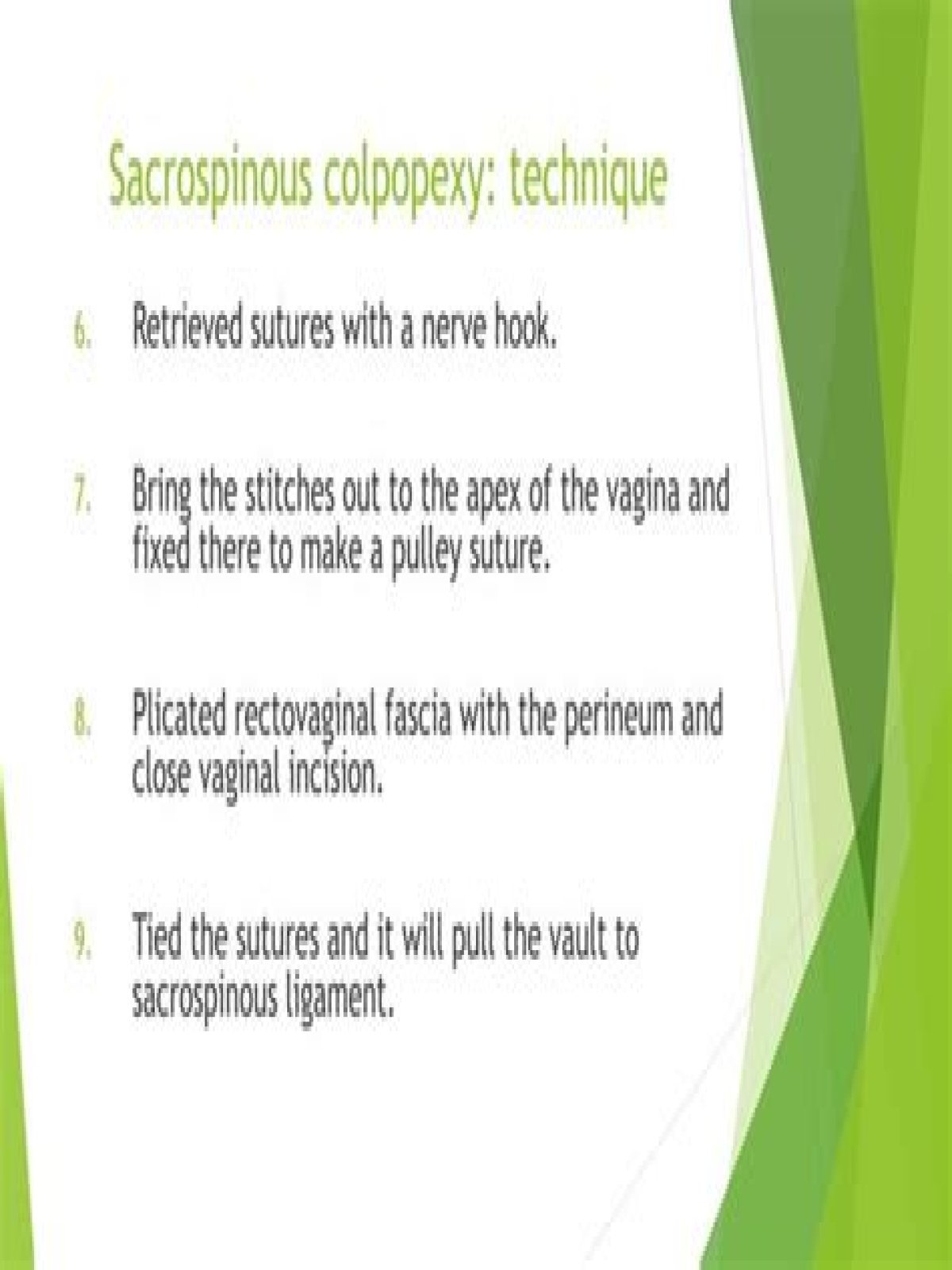What is sacrospinous colpopexy?
Sacral colpopexy, also known as sacrocolpopexy or sacrospinous colpopexy, is a surgical procedure used to correct pelvic organ prolapse in women. When the muscles around a woman’s pelvis weaken, the pelvic organs can prolapse (slide out of place). This creates a bulge in the vagina.
What is sacrospinous Hysteropexy?
A sacrospinous hysteropexy involves supporting the uterus using stitches to fix it to a strong ligament inside the pelvis. The operation is performed through the vagina and is often performed at the same time as other prolapse operations such as anterior and posterior repair.
What is a colpopexy surgery?
Sacral colpopexy is a surgery used to repair pelvic organ prolapse. This is a condition where your pelvic organs, such as your vagina and uterus, sag or fall out. Sacral colpopexy treats pelvic organ prolapse by putting your organs back where they should be.
What is the sacrospinous ligament?
The sacrospinous and sacrotuberous ligaments connect the sacrum to the ischium. The sacrospinous ligament, originating from the lateral margin of the inferior sacrum and attaching at the ischial spine, assists in resisting external rotation forces of the pelvis.
Is Sacrocolpopexy a major surgery?
Sacrocolpopexy is a major surgical procedure to treat prolapse of the vault (top) of the vagina in women who have had a previous hysterectomy by fixing it to the sacrum using a graft or mesh.
How long does a Sacrospinous fixation take?
The surgical procedure takes approximately 1 to 1.5 hour to perform when performed with additional procedures to correct a cystocele or rectocele. You will be under general anesthesia during the procedure.
What is Sacrospinous surgery?
A sacrospinous ligament suspension is a surgical procedure to restore the support of the top of the vagina, most commonly after hysterectomy. It can be performed at the same time as a hysterectomy, or later on in life in women who have previously undergone a hysterectomy.
How long does a sacral Colpopexy take?
The surgery takes 2-3 hours to complete. When it is over, the patient will be taken to the Post-Anesthesia Care Unit (PACU) to wake up from anesthesia.
Is Robotic Sacrocolpopexy safe?
Conclusions: Robotic assisted laparoscopic sacrocolpopexy represents a safe and effective surgical therapy to manage symptomatic apical pelvic organ prolapse. Serious complication rates are low but not rare when assessing short-term outcomes.
What does sacrospinous ligament pain feel like?
It is anterior to the medial margin of glut maximus, lateral to the upper gluteal cleft not on the muscle itself. Press into the ligament, you will feel roby / hard sensation underneath your fingers. Compare both sides and stay longer on the side you feel that is more restrict or less bony space.
Sacrospinous / Uterosacral Colpopexy AIM: This surgery offers support to the upper vagina minimising risk of recurrent prolapse at this site. Indication: Upper vaginal prolapse (uterine or vault prolapse, enteroceles). This procedure can be used in reconstructive vaginal surgery where increased vaginal length is required.
Can transvaginal sacrospinous ligament fixation be used for uterovaginal prolapse?
In the present study, transvaginal sacrospinous ligament fixation technique was used as part of the vaginal repair procedure for marked uterovaginal prolapse and vault prolapse. Injury to the pudendal nerve, internal pudendal artery and vein, ureter and rectum is a possible complication.
How do you dissection a sacrospinous ligament?
Using sharp and blunt dissection the sacrospinous ligament running from the ischial spine to the sacral bone is palpated and identified (A). Two sutures are placed through the strong ligament and secured to the top of the vagina. This results in increased support to the upper vagina.
What to expect during sacrospinous ligament suspension and vaginal wall repair?
Sacrospinous Ligament Suspension and Vaginal Wall Repair – 4 – 1 • A tube (catheter) will be placed in your bladder to drain urine and monitor. 2 the amount of urine coming out during surgery. 3 removed before you go home. 4 • Compression stockings will be placed on your legs to prevent blood clots in. 5 your legs during surgery.
